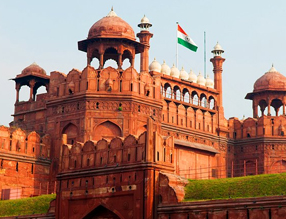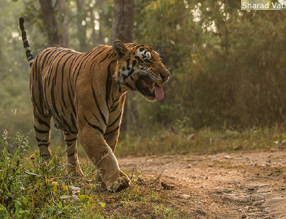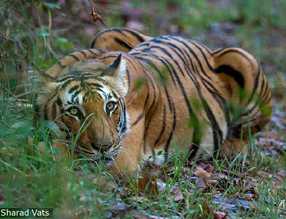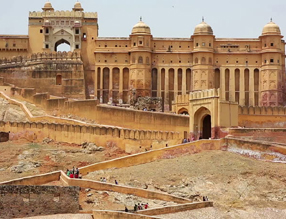Duration: 15 Nights / 16 Days
Place to visit: New Delhi –Raipur- Kanha - Bandhavgarh – Jabalpur – New Delhi – Agra – Jaipur- Jodhpur – Udaipur - New Delhi - Fly Back Home
 Day 01: Arrive New Delhi (by flight)
Day 01: Arrive New Delhi (by flight)
On arrival at Delhi airport, you will be met by our representative who will transfer you to your hotel, assist you in check in at the hotel, handover and explain all travel related documents.
In the afternoon visit Qutab Minar, the tallest stone tower in India; India Gate – A War Memorial Arch. Also drive past the President’s house, Parliament house, Government secretariat buildings and Connaught place – the heart of New Delhi and a busy shopping center.
Overnight stay is at the hotel.
Day 02: New Delhi – Raipur – Kanha (by flight + 210 kms/4 hrs drive)
Morning transfer to the airport to board a flight at 0520hrs to arrive Raipur at 0705 hrs Met at the Raipur airport and drive to Kanha National Park 210 kms / 4 hours drive.
Lunch at resort and afternoon game drive to the national park. Kanha is located right in the heart of India, which also gives you an opportunity to experience the rural, tribal, and agricultural parts of India.
Dinner and overnight at resort.
Day 03: In Kanha
Wake up at 0500hrs, tea coffee with biscuits, and proceed for the morning safari to the National park. Kanha's sal and bamboo forests, rolling grasslands and meandering streams stretch over 940 sq km in dramatic natural splendor which form the core of the Kanha Tiger Reserve created in 1974 under Project Tiger. The park is the only habitat of the rare hardground Barasingha (Cervus Duvaceli Branderi).
This is the original Kipling country of which he wrote so vividly in his Jungle Book. Packed breakfast which comes from the Lodge is served at a designated spot and spread on the bonnet of the Safari vehicle. Enjoy your breakfast in the wilderness of Kanha.
Continue your search for the elusive Tiger if you have not yet seen the same, and soak in the fresh, and energizing environment. Return from Safari around 1130hrs. Freshen up, and Lunch is served. Depart for evening jeep safari Kanha National Park. Return at 6pm from safari. Dinner and overnight at the Lodge.
Dinner and overnight at the Lodge.
 Day 04: In Kanha
Day 04: In Kanha
Wake up, and get ready for another day of adventure in the National park. The forests of the Banjar valley and Halon valley, respectively forming Kanha's western and eastern halves. By a special statute in 1955, Kanha National Park came into being. Since then, a string of stringent conservation programmes have been launched, for the overall protection of the park's fauna and flora. Kanha boasts of about 38 species of mammals. Some of the inhabitants of this park are the gaur, the largest of the world's cattle; the sambar, the largest Indian deer; and the chausingha, the only four-horned antelope in the world. Other frequent visitors include the Nilgai antelope, the sloth bear, the dhole, or Indian wild dog, and an occasional Leopard. Some 300 species of birds inhabit the park, that includes the storks, egrets, black ibis, raptors, owls, and the red-wattled lapwings.
Depart for evening jeep safari Kanha National Park. Return at 6pm from safari. Dinner and overnight at the Lodge
Day 05: Kanha – Bandhavgarh (by surface 280 kms/6 hrs drive )
Morning game drive to the national a park and later depart for Bandhavgarh, 280kms, 6 hours drive. On arrival check into the Lodge. Dinner and overnight at the Lodge.
Day 06: In Bandhavgarh
Breakfast, Lunch and Dinner at the Resort. Morning Jeep drives in the park
Bandhavgarh: The national park is mainly known for the density of its tiger population. The other wild attractions in the park include Leopards, Blue Bulls, Indian Gaur (Bison) Chausingha (Four Horned Antelopes), Spotted Deers, Sambar Deer, Wild Boar, Sloth Bears Fox, Jackals, Wild Dogs, etc. There are at least 22 mammal species and about 250 bird species in the Park. The other animals found in Bandhavgarh are Ratel, Porcupine, Small Indian Civet, Palm Squirrel, Lesser Bandicoot rat, the Jungle Cat, and the shy Hyenas. The reptile population in the park includes Cobras, Kraits, Vipers, Ratsnakes, Pythons, Monitor Lizards and turtles. The two primate species - the rhesus macaque and the Hanuman langur - inhabit Bandhavgarh.
Dinner and overnight at the Resort
 Day 07: In Bandhavgarh
Day 07: In Bandhavgarh
Breakfast, Lunch and Dinner at the Resort. Morning & evening Jeep drives in the park.
Bandhavgarh has been a center of human activity and settlement for over 2000 years, and there are references to it in the ancient books, the Narad-Panch Ratra and the Shiva Purana.
The oldest sign of habitation in the park are caves dug into the sandstone to the north of the fort. Several contain Brahmi inscriptions dating from the 1st century B.C. Various dynasties have ruled the fort, for example, the Maghas from the 1st century A.D., the Vakatakas from the 3rd century A.D. From that time onwards Bandhavgarh was ruled by a succession of dynasties including the Chandela Kings. Bandhavgarh became more and more deserted until forest overran the area band it became the royal hunting reserve. At independence Bandhavgarh remained the private property of the Maharaja until he gave it to the state for the formation of the National Park in 1968. After the park was created poaching and hunting was brought under control and the number of animals rose dramatically. The Tigers in particular prospered and the 1986 extension provided much needed forest to accommodate them.
Overnight at the resort.
Day 08: Bandhavgarh – Jabalpur – New Delhi (by road 200 kms / 4 hrs drive)
Morning Jeep drive in the park. After lunch drive to Jabalpur airport 200 kms /4hrs drive to board a flight to New Delhi at 1825 hrs. Arrive New Delhi at 2020 hrs and transfer to hotel.
Overnight at New Delhi.
Day 09: New Delhi - Agra (by road, 220kms, 4 hours drive)
After breakfast drive to Agra 220 kms/4 hrs drive. On arrival check into the hotel.
Later proceed to visit the red sandstone AGRA FORT which stands like a crescent on the banks of Yamuna River enclosed by forbidding 20-meter high walls, with a 12- meter moat between them. Three successive Mughal emperors - Akbar, Jehangir and Shah Jehan - helped create this massive structure which contains Hindu and Muslim architecture.
Overnight stay at the hotel in Agra.
Day 10: Agra – Jaipur (by road, 235kms, 5-6 hours drive)
After breakfast, proceed to visit the famous white marble mausoleum, The Taj Mahal, which was built in the middle of the 17th century by the Moghul emperor Shah Jehan for his wife Mumtaz Mahal. Completed in 1652, skilled craftsmen from Persia, Turkey, France and Italy and some 20,000 labourers worked for 17 years to build this edifice. Later proceed to visit the red sandstone AGRA FORT which stands like a crescent on the banks of Yamuna River enclosed by forbidding 20-meter high walls, with a 12- meter moat between them. Three successive Mughal emperors - Akbar, Jehangir and Shah Jehan - helped create this massive structure which contains Hindu and Muslim architecture. [The Taj is closed on Friday]. Check out from the hotel.
Later drive to Jaipur 235 kms/5-6 hrs drive enroute visit Fatehpur Sikari. On arrival check into Hotel.
Overnight stay at the hotel in Jaipur.
Day 11: Jaipur
This morning you will drive 11kms in the outskirts of the city to visit Amber Fort, the ancient capital of the State until 1728. Visit the Temple of Kali, the Hall of Victory or Jai Mahal and Jagmandir. You can have the unique experience of traveling on elephant back to and from the top of the hill on which the fort is situated.
In the afternoon visit the Observatory, the Palace of Winds and the City Palace and Museum. The museum has an interesting textile section, which contains dresses and costumes of the former Maharajas and Maharanis of Jaipur. Jaipur is well known for its beautiful carpets, enamelled ornaments, precious and semi-precious stones, brass ornaments and many other arts and crafts.
Spend time in crowded lanes & by lanes of pink city, haggling and souvenir-hunting in the evening.
Overnight stay at the Hotel.
 Day 12: Jaipur – Jodhpur ( by road 330 kms/6 hrs drive)
Day 12: Jaipur – Jodhpur ( by road 330 kms/6 hrs drive)
After breakfast drive to Jodhpur 330 kms, 6 hrs drive. Jodhpur Famous for its magnificent forts and palaces, Jodhpur is the second largest city of Rajasthan and a major tourist attraction in the country. The city is situated at the edge of the Thar Desert with Jaisalmer on its west, Barmar, Jalor and Pali on its south, Bikaner on its north, and Nagaur on the eastern side. The city dominated by the massive Mehrangarh fort on a rocky hill is charming with its wealth of historic attractions and colourful markets which specializes in antiques. It is still one of the leading centres of wool, cattle, camels and salt.
Overnight stay at the hotel in Jodhpur.
Day 13: Jodhpur –Udaipur (250 kms/5 hrs drive)
After breakfast visit the Majestic Meharangarh Fort,situated on a low sandstone hill. Within the fort, visit Moti Mahal and Phool Mahal. Jodhpur was founded by the Rajput chief Rao Jodha in 1459. The city was the erstwhile capital of the Marwar state. A 10-km-long wall made of stone and built about a century after the city was founded, surrounds the old city. There are about 100 towers in the city, most of which are surrounded by defensive battlements. It was founded in 1459 A.D. by Rao Jodha-chief of the Rathore clan of Rajputs who claimed to be descendants of Rama - hero of the epic 'Ramayana'. Rathores controlled a large part of Rajasthan, especially during the reigns of Rao Udai Singh (1581 AD) and his son Raja Sur Singh ((1595), who conquered Gujarat and a good part of Deccan for the Mughal Emperor Akbar. The Rathores always had good relationships with the Mughals and Maharaja Jaswant Singh (1678) supported Shahjahan in the Mughal struggle for war of succession. Only problematic relationship they had was with Aurangzeb. After the death of Aurangzeb in 1707, Maharaja Ajit Singh became the ruler of Jodhpur. He drove out Mughals from Ajmer and added substantially to the Mehrangarh Fort.
Later drive to Udaipur 250 ksm/5 hrs drive, enroute visit Ranakpur. Ranakpur is a village located in Desuri tehsil near Sadri town in the Pali district of Rajasthan in western India. It is located between Jodhpur and Udaipur. 162 km from Jodhpur and 91 km from Udaipur, in a valley on the western side of the Aravalli Range. The Nearest Railway Station to reach Ranakpur is Falna Railway station. Ranakpur is one among the most famous places to visit in Pali, Rajasthan. Ranakpur is easily accessed by road from Udaipur.
Along with magnificent architecture and numerous pillars, the place is also famous for large population of monkeys that live in and around the place. Ranakpur is widely known for its marble Jain temple, said to be the most spectacular of the Jain temples. There is also a small Sun temple which is managed by the Udaipur royal family trust.
Later drive to Udaipur 250 kms/ 5 hrs drive. On arrival check into hotel .
Udaipur The city of Lakes, Located in the Aravalli ranges of Rajasthan, the city of Udaipur is situated at a distance of about 405 km from the state capital Jaipur. The City of Dawn, surrounded by the ancient Aravali Mountains and set on the edge of three lakes, is a brilliant kaleidoscope of narrow lanes flanked by bright stalls, gardens, lakes, palaces and temples. The city is famous for its palaces, lake, museums, temples, and gardens and much more
Overnight stay at the hotel in Udaipur
Day 14: Udaipur
Morning full day city tour of Udaipur including a boat ride at Lake Pichola. The city was founded in 1567 AD by Maharana Udai Singh on the advice of a sage. Udaipur was last of the numerous Mewar capitals. It was in Udaipur that legendary Maharana Pratap was born. He was obsessed with Chittaur and the past glories of the Sisodia clan possessed his mind. Maharana Pratap left Udaipur to win back Chittaur from the Mughals. But he failed in his attempts and Udaipur remained the capital of Mewar till India got her independence. The memory of the failure of noble Pratap gives Udaipur its pervading mood of nostalgic wistfulness.
The city acquires its scenic beauty from the Aravallis. Three lakes- Pichola, Fateh Sagar and Udai Sagar make it an oasis in the desert.
Day 15: Udaipur – New Delhi (by flight)
After breakfast visit the Chittorgarh Fort is one of the largest forts in India. It is a World Heritage Site. The fort, popularly known as Chittor, was the capital of Mewar and is today situated in Chittorgarh.
Chittorgarh Fort is one of the largest forts in India. It is a World Heritage Site. The fort, popularly known as Chittor, was the capital of Mewar and is today situated in Chittorgarh. It was initially ruled by Guhilot and later by Sisodias, the Suryavanshi clans of Chattari Rajputs, from the 7th century, until it was finally abandoned in 1568 after the siege by Emperor Akbar in 1567. It sprawls majestically over a hill 180 m (590.6 ft) in height spread over an area of 280 ha (691.9 acres) above the plains of the valley drained by the Berach River. The fort precinct with an evocative history is studded with a series of historical palaces, gates, temples and two prominent commemoration towers. These monumental ruins have inspired the imagination of tourists and writers for centuries
The fort was sacked three times between the 15th and 16th centuries; in 1303 Allauddin Khilji defeated Rana Ratan Singh, in 1535 Bahadur Shah, the Sultan of Gujarat defeated Bikramjeet Singh and in 1567 Akbar defeated Maharana Udai Singh II who left the fort and founded Udaipur. Each time the men fought bravely rushing out of the fort walls charging the enemy but lost every time. Following these defeats, Jauhar was committed thrice by more than 13,000 ladies and children of the Rajput heroes who laid their lives in battles at Chittorgarh Fort, first led by Rani Padmini wife of Rana Rattan Singh who was killed in the battle in 1303, and later by Rani Karnavati in 1537 AD
Thus, the fort represents the quintessence of tribute to the nationalism, courage, medieval chivalry and sacrifice exhibited by the Mewar rulers of Sisodia and their kinsmen and women and children, between the 7th and 16th centuries. The rulers, their soldiers, the women folk of royalty and the commoners considered death as a better option than dishonor in the face of surrender to the foreign invading armies.
Late afternoon transfer to the airport to board a flight to New Delhi 1920 hrs to arrive New Delhi at 2040 hrs. Met at the airport and transfer to the hotel. Overnight stay at the hotel.
Day 16: New Delhi Fly back home
After breakfast free for leisure activity and evening transfer to international airport to board a flight back home.
End of our services
Note: The driving hours given above from one city to another are based on the normal conditions of the roads and may vary. Any break for Food / Tea / Toilets / Sightseeing on the way will take extra time than the above given hours. Kanha and Bandhavgarh National park is closed every Wednesday for afternoon jeep safari
